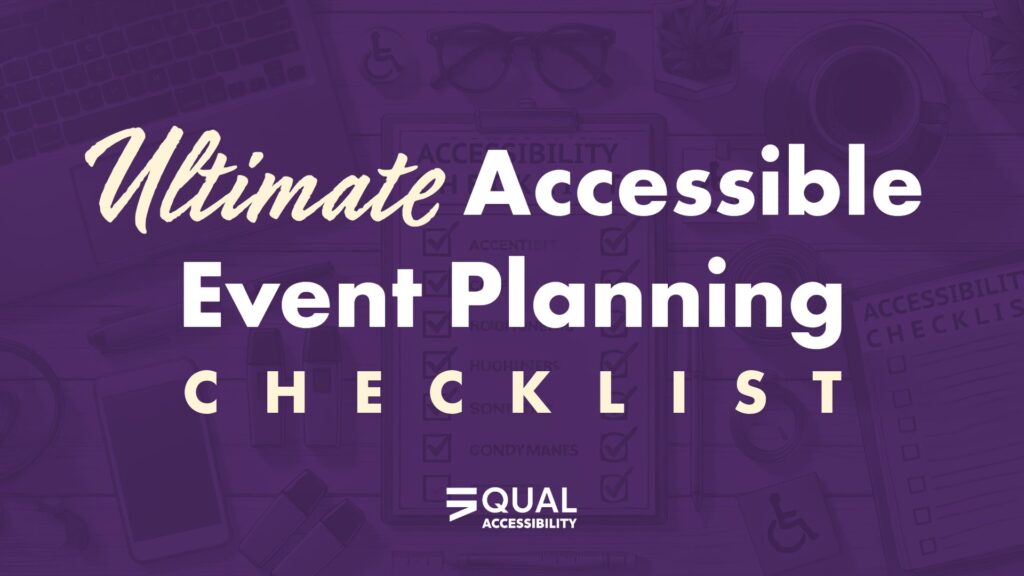Accessible Event Planning: It’s Not Just a Box to Check
When you’re planning an event—whether it’s a company retreat, outdoor music festival, university commencement, or neighborhood celebration—you want to make sure every guest has an incredible experience. But all too often, accessibility is treated as a last-minute concern or a confusing technicality. That mindset doesn’t just risk alienating your audience—it can turn what should be a celebration into a source of frustration for people with disabilities. Accessible event planning is more than a checkbox—it’s how we create spaces where everyone feels valued.
At Equal Accessibility, we’ve helped organizations of all sizes create inclusive, welcoming events that do more than meet the letter of the law—they build genuine, memorable connections. We’ve also seen firsthand what happens when accessibility is overlooked. Guests who can’t find a restroom they can use, ramps that are too steep to navigate, no space for a wheelchair near the stage, or audio that’s impossible to hear. These aren’t small details—they’re dealbreakers.
Accessible event planning is not about perfection. It’s about intention.
The best events are built with empathy, and accessibility is a powerful way to show your audience that they matter. By planning for access from the very beginning, you’re telling every attendee: “We thought about you. We want you here. You belong.”
This accessible event planning checklist is for event planners, venue coordinators, nonprofit leaders, corporate teams, volunteers, and anyone else who’s responsible for shaping an experience that includes a diverse audience. Whether you’re just getting started or you’ve planned dozens of events before, this resource is meant to simplify the process, answer your questions, and help you anticipate needs before they become problems.
You don’t have to do it all alone—and you don’t have to get it all perfect. But you do have to try. And trying means planning ahead, asking thoughtful questions, and listening to the people who are most affected.
To simplify the process of accessible event planning, we created this checklist to help you think through key details early.
Pre-Planning & Vendor Selection
- Involve people with disabilities during planning
- Hire vendors and partners who understand accessibility expectations
- Create an accessibility budget (include ramps, interpreters, materials, etc.)
- Confirm accessibility with each vendor (especially restroom providers, AV teams, transportation)
Venue Selection
- Accessible parking spaces near entrances
- Curb cuts, smooth pathways, and no loose gravel or sand
- Clearly marked, step-free entrances with automatic or easy-open doors
- Elevators available if the venue is multi-story
- Indoor and outdoor spaces have firm, stable, and slip-resistant surfaces
Restrooms
- Permanent or portable restrooms are ADA compliant
- Doors are wide enough for power chairs and scooters
- Stall doors have a Door Nub® handle installed
- Turning radius inside meets or exceeds 60 inches
- Support/grab bars installed appropriately
- Well-lit and clearly marked signs (with braille or tactile options)
Seating & Layout
- Accessible seating is available throughout (not just at the back!)
- Companion seating is next to accessible seats
- No raised or sunken areas without ramps or lifts
- Space for service animals to rest
- Designated quiet/sensory-friendly area, if possible
Audio, Visual & Communication Access
- ASL interpreters available for stage or panel content
- Live captioning (CART) or closed captioning for pre-recorded video
- Assistive listening devices provided
- Visuals described aloud during presentations or performances
- No strobe lights or flashing visuals unless clearly disclosed
Printed & Digital Materials
- Registration forms allow attendees to request accommodations
- Digital materials are screen reader-friendly (accessible PDFs, alt text)
- Large print and plain language versions available upon request
- Signage is high-contrast, in large font, and mounted at appropriate height
- Event app or website meets WCAG 2.1 AA guidelines
Wayfinding & Transportation
- Shuttle buses or rideshare zones are wheelchair accessible
- Clear signage with tactile/braille options for restrooms, exits, info
- Volunteer/staff available to assist with directions and navigation
- Mobility maps or site layout includes accessible routes and entry points
- Drop-off areas are level and close to main entrances
Comfort & Safety
- Climate-controlled tents or cooling/shaded areas for outdoor events
- First aid staffed and stocked with necessary supplies
- Fragrance-free policy promoted (including cleaning products and hand soaps)
- Emergency exits are accessible
- Staff knows how to handle accessibility-related emergencies
Staff & Volunteer Training
- All staff and volunteers receive disability etiquette training
- Staff knows location of accessibility accommodations
- Accessibility Point-of-Contact designated and introduced to attendees
- Staff can respectfully assist without making assumptions
- Emergency plans include evacuation procedures for people with disabilities
Communication & Feedback
- Accessibility info is clearly communicated on event page and social media
- Contact listed for accommodation requests (email + phone)
- Accommodations are confirmed in advance with attendees
- Post-event survey includes specific questions about accessibility experience
- Feedback is reviewed and used to improve future events
Bonus: Thoughtful Touches
- Sensory kits available (earplugs, sunglasses, fidget tools)
- Volunteers with lived disability experience on hand
- Visual schedules for neurodivergent guests
- Rest spaces for people with fatigue or chronic pain
- Inclusion statement shared in opening remarks and printed materials
Conclusion: Let’s Raise the Bar
This accessible event planning checklist is more than a task list—it’s a mindset. Accessibility isn’t about doing the bare minimum. It’s about designing experiences where nobody has to ask, adjust, or be reminded they were an afterthought. Whether you’re planning your first event or your fiftieth, we hope this guide helps you create a space where everyone feels seen.
Want support evaluating your site or need help creating a full accessibility strategy? We’re here for you.
Contact Equal Accessibility to help with your accessible event planning so everyone can attend with confidence.
Additional Accessible Event Planning Resources: ADA Requirements for Outdoor Events – VIP To Go Accessible Meeting Facilities Checklist – Georgia Tech Special Events
